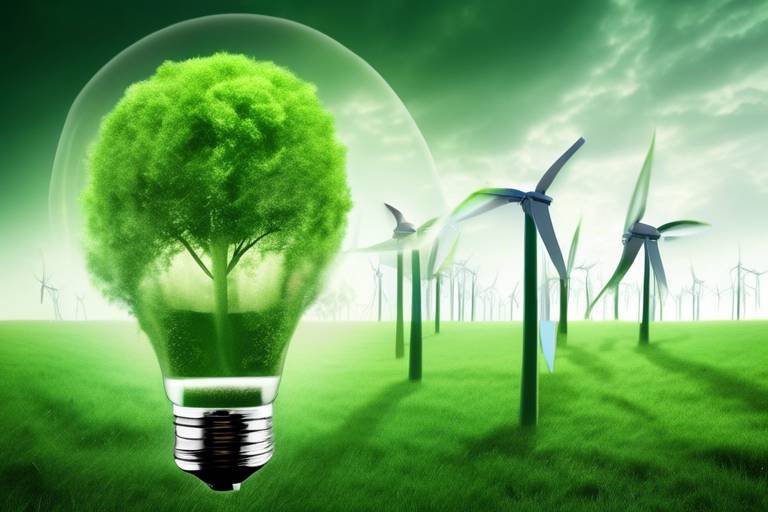Can Green Energy Solutions Cater to Industrial Needs?
The question of whether green energy solutions can cater to industrial needs is increasingly becoming a hot topic in today's world. As industries continue to evolve, the demand for sustainable practices is rising, driven by both environmental concerns and economic incentives. Many companies are now recognizing that embracing green energy is not just a trend but a crucial step towards ensuring their long-term viability and competitiveness. But what does this really mean for industries? Let’s dive deeper into the potential of green energy in meeting industrial demands.
In recent years, we've witnessed a significant shift in how industries approach energy consumption. Gone are the days when fossil fuels were the primary source of energy for manufacturing and production. Today, a growing number of companies are turning to renewable energy sources such as solar, wind, and biomass. This transition is not only motivated by a desire to reduce carbon footprints but also by the realization that sustainable practices can lead to greater economic efficiency.
Factors such as climate change, resource scarcity, and consumer demand for environmentally friendly products are pushing industries to adopt green energy solutions. Companies that once relied solely on traditional energy sources are now exploring innovative alternatives that not only meet their energy needs but also align with their corporate social responsibility goals. The result? A new era of industrial operations that prioritize sustainability without sacrificing productivity.
Implementing green energy technologies offers a plethora of benefits that can significantly impact an industry's bottom line. First and foremost, there are the financial advantages. By reducing reliance on fossil fuels, companies can enjoy lower energy bills and decreased operational costs. Furthermore, many governments are offering incentives for businesses that invest in sustainable energy, making the switch even more appealing.
When it comes to cost efficiency, green energy solutions can be a game changer. Industries that adopt these technologies often see substantial long-term savings. For instance:
- Lower energy bills due to reduced consumption of fossil fuels.
- Reduced operational costs through improved energy efficiency.
- Potential government incentives that can offset initial investment costs.
Many governments worldwide are actively promoting green energy adoption through various programs and incentives. These can include tax credits, grants, and subsidies designed to encourage industries to invest in renewable energy sources. By capitalizing on these incentives, companies can significantly reduce their initial investment in green technology, making it a more viable option.
Beyond immediate cost savings, investing in green energy can lead to long-term financial benefits. Industries that transition to renewable energy sources often experience:
- Increased asset value as sustainability becomes a key performance indicator.
- Enhanced resilience against fluctuating energy prices, leading to more predictable budgeting.
- Improved profitability as consumers increasingly favor environmentally responsible companies.
The environmental benefits of adopting green energy solutions are profound. By shifting to renewable energy, industries can drastically reduce their greenhouse gas emissions, contributing to a healthier planet. Moreover, this shift promotes sustainable resource management practices, ensuring that future generations have access to the resources they need.
Despite the numerous benefits, transitioning to green energy solutions is not without its challenges. Industries may face several obstacles, including high initial costs, technological limitations, and regulatory hurdles. These factors can create a daunting landscape for companies looking to make the switch.
One of the primary challenges industries encounter is the need for advanced infrastructure. Integrating new green technologies with existing systems can be complex and costly. Industries must invest in research and development to overcome these technological barriers and ensure a smooth transition.
The regulatory landscape surrounding green energy can also pose challenges. Compliance with various laws and standards can be cumbersome, and navigating this landscape requires careful planning and expertise. Industries must stay informed about the latest regulations to ensure they remain compliant while implementing sustainable practices.
Q: What types of green energy solutions are available for industries?
A: Industries can utilize a variety of green energy solutions, including solar power, wind energy, biomass, and geothermal energy, depending on their specific needs and geographical location.
Q: Are there financial incentives for businesses adopting green energy?
A: Yes, many governments offer financial incentives such as tax credits, grants, and subsidies to encourage businesses to invest in green energy solutions.
Q: What are the long-term benefits of switching to green energy?
A: Long-term benefits include reduced energy costs, increased asset value, and improved brand reputation as consumers increasingly favor environmentally responsible companies.

The Rise of Green Energy in Industry
In recent years, the buzz surrounding green energy has transformed from mere chatter into a powerful movement, especially within industrial sectors. As businesses grapple with the pressing need to reduce their environmental impact, the adoption of sustainable energy solutions has become not just a trend, but a necessity. This shift is largely driven by a combination of environmental awareness and economic incentives, pushing industries to rethink their energy sources.
Imagine a world where factories and plants operate not just efficiently, but also in harmony with the environment. This vision is becoming a reality as industries increasingly embrace renewable energy sources like solar, wind, and hydroelectric power. According to recent studies, the industrial sector accounts for a substantial portion of global energy consumption, making it a prime target for green energy initiatives. The transition is not just about saving the planet; it’s also about staying competitive in a rapidly evolving market.
One of the driving forces behind this transition is the mounting pressure from consumers who are becoming more conscious of their choices. Today’s consumers prefer brands that demonstrate a commitment to sustainability, pushing companies to adopt eco-friendly practices in order to maintain their market share. Furthermore, as regulations tighten around carbon emissions, industries are finding that shifting to green energy is not only beneficial for the environment but also essential for compliance with new laws.
Another significant factor contributing to the rise of green energy in industry is the falling cost of renewable technologies. Over the past decade, advancements in technology have made solar panels and wind turbines more affordable and efficient. This has led to a surge in investment, with many companies now viewing green energy not just as an ethical choice, but as a financial opportunity. A recent report highlighted that businesses investing in renewable energy can expect a return on investment within just a few years, thanks to lower energy costs and potential government incentives.
Moreover, the integration of green energy solutions is becoming more accessible due to the development of innovative technologies. For instance, energy storage systems are evolving, allowing industries to store excess energy generated during peak production times for later use. This capability not only enhances energy reliability but also maximizes efficiency, making it easier for industries to transition to renewable sources without sacrificing productivity.
In summary, the rise of green energy in industry is a multifaceted phenomenon fueled by environmental concerns, consumer demands, and economic advantages. As industries continue to innovate and adapt, the future looks bright for sustainable practices. The question is no longer whether industries will adopt green energy solutions, but rather how quickly they can transition to a more sustainable model that benefits both their bottom line and the planet.

Benefits of Green Energy Solutions
When it comes to the industrial landscape, the shift towards green energy solutions is not just a trend; it's a revolution that is reshaping how businesses operate. The benefits of adopting these sustainable practices are manifold, making a compelling case for industries to embrace them. First and foremost, green energy leads to significant cost savings. Imagine reducing your energy bills while simultaneously contributing to a healthier planet. It’s like hitting two birds with one stone! By investing in renewable energy sources, industries can lower their operational costs over time, which is a win-win situation.
Moreover, the environmental impact of green energy solutions cannot be overstated. Industries that transition to renewable sources such as solar, wind, or hydroelectric power significantly reduce their carbon footprints. This reduction in greenhouse gas emissions is crucial in combating climate change and promoting a sustainable future. Think of it this way: every kilowatt of clean energy generated is a step towards a cleaner, greener planet. It’s not just about saving money; it’s about being a responsible corporate citizen.
Additionally, there’s a growing expectation from consumers and stakeholders for businesses to demonstrate corporate social responsibility. By adopting green energy solutions, companies can enhance their brand image and attract environmentally-conscious customers. It’s like wearing a badge of honor that says, “We care about our planet!” This not only improves customer loyalty but can also lead to new business opportunities as more clients prefer to work with companies that prioritize sustainability.
One of the most attractive aspects of green energy solutions is their potential for long-term cost efficiency. While the initial investment might seem daunting, the reality is that industries can save a significant amount of money over time. For example, businesses that install solar panels can benefit from lower energy costs and even sell excess energy back to the grid, creating an additional revenue stream. According to recent studies, companies that switch to green energy can see a reduction of up to 30% in their energy bills within the first few years.
To sweeten the deal even further, many governments offer a variety of incentives for companies that invest in green energy solutions. These can range from tax credits to grants and rebates that help offset the initial costs of switching to renewable energy sources. For instance, the federal government in the United States has implemented several programs aimed at encouraging businesses to adopt solar energy. This level of support can make the transition not only feasible but also profitable.
In examining the long-term financial benefits of green energy investments, it’s essential to consider the resilience against fluctuating energy prices. By investing in renewable energy, companies can shield themselves from the volatility of fossil fuel markets. This stability can lead to increased asset value and, ultimately, enhanced profitability. Picture this: a company that relies on solar energy is less affected by rising oil prices, allowing it to maintain its operational budget and focus on growth rather than survival.
Finally, the positive environmental impacts of green energy adoption are profound. Industries that commit to renewable energy not only reduce their greenhouse gas emissions but also promote sustainable resource management practices. This commitment can lead to healthier ecosystems and a more sustainable future for generations to come. When industries prioritize green energy, they contribute to a collective effort that benefits not just their bottom line but also the planet. It’s a legacy of sustainability that they can be proud of.

Cost Efficiency and Savings
When it comes to green energy solutions, one of the most compelling arguments for their adoption in industries is the potential for . Many businesses are initially hesitant to invest in renewable energy technologies due to perceived high upfront costs. However, as the saying goes, "You have to spend money to make money." This adage rings particularly true in the realm of green energy. Once these systems are in place, the long-term savings can be substantial.
Let’s break it down. First off, consider the lower energy bills. By utilizing renewable sources such as solar or wind power, industries can significantly reduce their dependence on traditional energy sources, which are often subject to price volatility. For instance, a factory that installs solar panels can generate its own electricity, leading to a dramatic decrease in monthly energy expenses. In fact, studies have shown that companies can save anywhere from 20% to 50% on their energy bills after transitioning to green energy solutions.
Moreover, the reduction in operational costs is another key factor. When industries invest in energy-efficient technologies, they not only cut down on energy consumption but also reduce maintenance costs. For example, energy-efficient machinery often requires less upkeep and lasts longer than traditional equipment. This translates into lower operational costs over time, allowing businesses to redirect funds into other critical areas.
Additionally, many governments offer incentives for companies that adopt green energy solutions. These can come in the form of tax credits, grants, or rebates, which can significantly offset initial investment costs. By taking advantage of these programs, companies can recover a substantial portion of their investment, making the switch to green energy not just an environmentally friendly choice, but a financially savvy one as well.
| Type of Incentive | Description |
|---|---|
| Tax Credits | Reductions in tax liabilities for businesses investing in renewable energy. |
| Grants | Funds provided by the government to support green energy projects. |
| Rebates | Partial refunds for the purchase of energy-efficient equipment. |
Lastly, let’s not underestimate the long-term financial benefits of investing in green energy. Companies that adopt these solutions often see an increase in asset value. Properties equipped with renewable energy systems are perceived as more desirable and can command higher prices in the real estate market. Furthermore, as energy prices continue to fluctuate, businesses that have invested in green technologies are less vulnerable to these changes. This resilience is not just a safety net; it’s a strategic advantage in today’s competitive landscape.
In summary, the cost efficiency and savings associated with green energy solutions make them an attractive option for industries. By reducing energy bills, lowering operational costs, taking advantage of government incentives, and increasing asset value, businesses can not only enhance their profitability but also contribute to a more sustainable future. So, why not take that leap into green energy? The financial benefits are not just a dream; they are a tangible reality waiting to be seized.
- What are the main cost savings associated with green energy? Green energy can lead to lower energy bills, reduced operational costs, and potential government incentives.
- Are there government incentives for switching to green energy? Yes, many governments offer tax credits, grants, and rebates to encourage businesses to adopt renewable energy solutions.
- How do green energy investments affect asset value? Properties with renewable energy systems are often seen as more desirable and can command higher prices in the market.

Government Incentives for Green Energy
When it comes to transitioning towards green energy solutions, government incentives play a pivotal role in encouraging industries to adopt sustainable practices. These incentives can take various forms, ranging from tax credits and grants to rebates and low-interest loans, all designed to alleviate the financial burden associated with the initial costs of implementing green technologies. For instance, many countries offer investment tax credits that allow businesses to deduct a significant percentage of their investment in renewable energy systems from their federal taxes. This not only reduces the upfront costs but also enhances the return on investment, making the transition to green energy more appealing.
Moreover, governments often establish grant programs aimed specifically at industries willing to invest in renewable energy projects. These grants can cover a substantial portion of the project costs, enabling companies to adopt technologies that they might otherwise consider too expensive. By providing financial support, governments are not only fostering innovation but also driving economic growth and job creation within the green energy sector.
In addition to direct financial incentives, many governments have also implemented renewable portfolio standards (RPS), which require utilities to obtain a certain percentage of their energy from renewable sources. This regulation creates a demand for green energy solutions, prompting industries to explore and invest in sustainable technologies to meet compliance requirements. As a result, businesses are not only contributing to environmental preservation but also positioning themselves competitively in a market that increasingly values sustainability.
Furthermore, it's essential to highlight that these incentives are not static; they are continually evolving to meet the dynamic needs of the industry. For example, as technology advances and the costs of renewable energy systems decrease, governments may adjust their incentive structures to ensure that they remain effective and relevant. This adaptability is crucial in maintaining momentum towards a greener industrial landscape.
To sum it up, government incentives for green energy are a vital catalyst for industrial adoption of sustainable practices. They provide the necessary financial support and regulatory framework that can significantly lower the barriers to entry for businesses looking to transition to renewable energy. As more industries take advantage of these incentives, we can expect to see a substantial shift towards a more sustainable future.

Long-Term Financial Benefits
When it comes to investing in green energy solutions, the long-term financial benefits can be nothing short of remarkable. Imagine a world where your energy bills are not just manageable but consistently decreasing over time! This is not merely a dream; it's a reality that many industries are beginning to experience as they shift towards sustainable energy sources. By embracing green technologies, businesses can enjoy significant savings in operational costs, which can lead to improved profit margins.
One of the most compelling aspects of green energy investments is the potential for increased asset value. Just like a well-maintained property appreciates over time, investments in renewable energy can enhance the overall value of a company’s assets. For instance, companies that install solar panels or wind turbines not only reduce their reliance on traditional energy sources but also increase the marketability of their facilities. This can be particularly beneficial when seeking financing or attracting investors who are increasingly looking for sustainable practices.
Moreover, the volatility of fossil fuel prices can wreak havoc on a company's bottom line. By investing in green energy, industries can mitigate this risk significantly. For example, organizations that harness solar or wind energy are less susceptible to the fluctuations of oil and gas prices. This stability can lead to better financial forecasting and planning, allowing companies to allocate resources more effectively. In essence, transitioning to renewable energy can act as a buffer against the unpredictable nature of the global energy market.
Additionally, there are numerous government incentives designed to encourage businesses to adopt green energy solutions. These can come in the form of tax credits, grants, and rebates, which can significantly offset the initial costs of investment. For instance, in many regions, companies can receive substantial tax deductions for installing renewable energy systems, further enhancing their financial viability. The combination of these incentives with the long-term savings can make green energy solutions not just a sustainable choice, but a financially savvy one as well.
In summary, the long-term financial benefits of adopting green energy solutions are multifaceted. From lower energy bills and reduced operational costs to increased asset value and protection against energy price fluctuations, the advantages are clear. As industries continue to embrace sustainability, those who invest in green technologies will likely find themselves in a stronger financial position, paving the way for future growth and innovation.
- What are the main financial benefits of green energy?
The primary financial benefits include lower operational costs, increased asset value, and potential government incentives.
- How do government incentives work for green energy?
Government incentives can include tax credits, grants, and rebates that help offset the initial investment costs of renewable energy technologies.
- Can green energy solutions protect against fluctuating energy prices?
Yes, by relying on renewable energy sources, companies can reduce their vulnerability to the volatility of fossil fuel prices.

Environmental Impact and Sustainability
The adoption of green energy solutions is not just a trend; it's a vital shift towards a more sustainable future for our planet. As industries increasingly recognize their role in environmental stewardship, the positive environmental impacts of green energy become more apparent. By transitioning to renewable energy sources such as solar, wind, and hydroelectric power, industries can significantly reduce their greenhouse gas emissions. This is crucial in the fight against climate change, which poses a serious threat to our ecosystems and way of life.
Imagine the difference it would make if every factory, office, and manufacturing plant switched to green energy. The potential for sustainability is enormous! For instance, according to recent studies, industries that have adopted renewable energy sources have seen a reduction in their carbon footprint by as much as 40%. This shift not only contributes to a healthier planet but also enhances the public image of businesses, as consumers increasingly favor companies that prioritize sustainable practices.
Moreover, the implementation of green energy technologies promotes sustainable resource management. By harnessing natural resources responsibly, industries can minimize waste and optimize energy efficiency. For example, using solar panels not only generates clean energy but also reduces dependence on fossil fuels, which are finite and harmful to the environment. Similarly, wind energy harnesses the power of the wind without depleting resources, making it a sustainable choice that can power entire cities.
However, the journey towards sustainability is not without its challenges. Industries must navigate the complexities of integrating these technologies into their existing operations. This involves not only financial investments but also a commitment to innovation and adaptation. As industries embrace these challenges, they pave the way for a greener future, cultivating a culture of sustainability that can resonate throughout the entire supply chain.
In summary, the environmental impact of adopting green energy solutions is profound. By reducing greenhouse gas emissions, promoting sustainable resource management, and enhancing corporate responsibility, industries can play a pivotal role in creating a sustainable future. The ripple effect of these changes can lead to healthier communities, a more stable climate, and a thriving economy that values sustainability. The question is, are we ready to embrace this change?
- What are green energy solutions? Green energy solutions refer to renewable energy sources like solar, wind, and hydroelectric power that are environmentally friendly and sustainable.
- How do green energy solutions impact the environment? They significantly reduce greenhouse gas emissions, promote sustainable resource management, and help combat climate change.
- What are the financial benefits of adopting green energy? Green energy can lead to long-term cost savings, lower operational costs, and potential government incentives.
- What challenges do industries face when implementing green energy? Industries may encounter high initial costs, technological barriers, and regulatory compliance issues.

Challenges in Implementing Green Energy Solutions
Transitioning to green energy solutions is not without its hurdles. While the benefits are substantial, industries often face several challenges that can slow down or complicate the adoption process. One of the most significant barriers is the high initial costs associated with implementing green technologies. For many companies, the upfront investment required for solar panels, wind turbines, or energy-efficient machinery can be daunting. It’s like trying to buy a new car when your old one still runs; you know the new one will save you money in the long run, but that initial price tag can be a tough pill to swallow.
Moreover, there are technological limitations that can impede progress. Industries may need to upgrade their existing infrastructure to accommodate new green technologies, which can be both time-consuming and expensive. For instance, integrating solar power systems into a manufacturing facility may require significant modifications to the electrical grid, which could disrupt operations. This is akin to trying to fit a square peg into a round hole; without proper adjustments, the system simply won’t work efficiently.
In addition to the financial and technological challenges, there are also regulatory hurdles that businesses must navigate. Compliance with various environmental laws and standards can be a complex process. Different regions have different regulations, and keeping up with these can feel like trying to hit a moving target. Companies might find themselves bogged down in paperwork and legalities, which can delay implementation and divert resources away from their core operations.
Furthermore, there’s often a lack of awareness and expertise within companies regarding green energy solutions. Many businesses may not fully understand the options available to them or how to effectively implement these technologies. This knowledge gap can lead to missed opportunities and inefficient strategies that fail to capitalize on the potential benefits of green energy.
Lastly, the market volatility associated with renewable energy sources can create uncertainty. For instance, fluctuations in the price of solar panels or wind turbine components can make budgeting and forecasting difficult. Industries need to be prepared for these changes, which adds another layer of complexity to the decision-making process.
Despite these challenges, the push towards green energy is gaining momentum. As more companies recognize the long-term benefits and as technology continues to advance, the barriers to adoption may lessen. The key is to approach these challenges with a strategic mindset, ensuring that investments in green energy are not just seen as costs, but as essential steps towards a sustainable future.
- What are the main challenges of implementing green energy solutions?
The main challenges include high initial costs, technological limitations, regulatory hurdles, lack of awareness, and market volatility.
- How can companies overcome the high costs associated with green energy?
Companies can explore government incentives, financing options, and long-term savings to offset initial investments.
- What role do regulations play in adopting green energy?
Regulations can either facilitate or hinder the adoption of green energy, depending on how they are structured and enforced.

Technological Barriers
This article explores the potential of green energy solutions to meet the demands of various industries, highlighting their benefits, challenges, and real-world applications in promoting sustainability and efficiency.
This section discusses the growing trend of adopting green energy solutions in various industrial sectors, emphasizing the environmental and economic factors driving this transition towards more sustainable practices.
Here, we outline the key advantages of implementing green energy technologies, including cost savings, reduced carbon footprints, and enhanced corporate social responsibility, making a compelling case for industrial adoption.
This subheading explores how green energy solutions can lead to significant long-term cost savings for industries, including lower energy bills, reduced operational costs, and potential government incentives for sustainable practices.
This section highlights various government programs and incentives available to industries that invest in green energy solutions, encouraging more businesses to make the switch to sustainable energy sources.
Here, we examine the long-term financial advantages of green energy investments, including increased asset value and resilience against fluctuating energy prices, ultimately enhancing profitability.
This subheading focuses on the positive environmental impacts of green energy adoption in industries, including reduced greenhouse gas emissions and the promotion of sustainable resource management practices.
In this section, we address the potential obstacles industries may face when transitioning to green energy, including high initial costs, technological limitations, and regulatory hurdles that can impede progress.
One of the most significant hurdles industries face when adopting green energy solutions is the technological barrier. This encompasses a variety of challenges that can impede the effective integration of renewable energy sources into existing systems. For starters, many industries rely on outdated infrastructure that is not designed to accommodate new technologies. This can lead to substantial costs associated with upgrading or replacing equipment to ensure compatibility with renewable energy systems.
Moreover, the integration of renewable energy technologies often requires advanced systems that can manage energy production and consumption efficiently. For example, industries may need to invest in battery storage systems or smart grid technologies to effectively harness intermittent energy sources like solar and wind. These technologies can be complex and require specialized knowledge for installation and maintenance, which many companies may not have readily available.
Another key aspect is the scalability of technology. While some green technologies work well on a small scale, scaling them up to meet industrial demands can present significant challenges. This is particularly true for energy sources that are still in the development phase, where reliability and efficiency may not yet be proven on a larger scale. As a result, industries may hesitate to invest heavily in technologies that could potentially underperform.
Lastly, the rapid pace of technological advancement can lead to a sense of uncertainty. Companies might be reluctant to adopt new technologies if they fear that a better solution will emerge shortly after their investment. This creates a paradox where industries are caught between the need to modernize and the fear of making the wrong choice.
Overall, while the potential for green energy solutions is vast, overcoming these technological barriers is essential for industries to fully realize the benefits of sustainable practices.
- What are green energy solutions? Green energy solutions refer to energy sources that are renewable and have a minimal impact on the environment, such as solar, wind, and hydroelectric power.
- Why should industries adopt green energy? Industries should adopt green energy to reduce their carbon footprint, save on energy costs, and enhance their corporate social responsibility.
- What are the main challenges of implementing green energy? The main challenges include high initial costs, technological limitations, and regulatory hurdles.
- How can governments support industries in adopting green energy? Governments can offer incentives, grants, and subsidies to encourage businesses to invest in renewable energy solutions.

Regulatory and Compliance Issues
When it comes to adopting green energy solutions, industries are often met with a labyrinth of regulatory and compliance issues that can feel overwhelming. Navigating these regulations is akin to walking through a dense forest; one wrong turn can lead to significant setbacks. Many businesses find themselves grappling with a patchwork of local, state, and federal regulations that govern energy use, emissions, and sustainability practices. These laws are designed to promote environmental responsibility, but they can also create hurdles for industries eager to make the switch to greener alternatives.
One of the primary challenges is the lack of uniformity in regulations. Different regions may have varying standards, which can complicate compliance for companies operating in multiple locations. For instance, while some states may offer generous incentives for solar energy adoption, others may impose stringent requirements that can be difficult to meet. This inconsistency can lead to confusion and increased administrative costs as businesses strive to ensure they are adhering to all applicable laws.
Moreover, the regulatory landscape is constantly evolving. New policies and amendments can emerge as governments respond to changing environmental priorities. Keeping up with these changes is crucial, yet it can be a daunting task for many organizations. Companies may find themselves in a race against time, trying to adapt their operations to align with new regulations while also managing their core business activities. This scenario can result in significant resource allocation towards compliance efforts, diverting attention from innovation and growth.
To mitigate these challenges, businesses can benefit from establishing robust compliance programs that not only monitor regulatory changes but also educate employees about the importance of adhering to environmental standards. For instance, companies can implement training sessions that focus on sustainability practices and compliance requirements. This proactive approach can foster a culture of environmental responsibility within the organization, ultimately leading to smoother transitions to green energy solutions.
Additionally, collaborating with industry associations and regulatory bodies can provide valuable insights and guidance. These partnerships can help businesses stay informed about upcoming changes and best practices for compliance. By engaging with stakeholders, companies can also advocate for more streamlined regulations that facilitate the adoption of green technologies.
In summary, while the regulatory and compliance landscape can pose significant challenges for industries looking to adopt green energy solutions, it is not insurmountable. With the right strategies in place, businesses can navigate these complexities and move towards a more sustainable future.
- What are the main regulatory challenges for industries adopting green energy?
Industries often face inconsistent regulations across regions, evolving compliance requirements, and the need for robust monitoring systems. - How can businesses stay updated on regulatory changes?
Establishing compliance programs, training employees, and collaborating with industry associations can help businesses stay informed. - What role do government incentives play in green energy adoption?
Government incentives can significantly reduce initial costs and encourage businesses to invest in sustainable energy solutions.
Frequently Asked Questions
- What are green energy solutions?
Green energy solutions refer to energy sources that are renewable and have a minimal environmental impact. This includes solar, wind, hydroelectric, and geothermal energy. Industries are increasingly adopting these solutions to reduce their carbon footprint and promote sustainability.
- How can green energy benefit my business?
Implementing green energy can lead to significant cost savings, lower operational expenses, and an enhanced reputation among consumers. Additionally, many governments offer incentives for businesses that invest in sustainable practices, which can further boost your bottom line.
- Are there any challenges in adopting green energy?
Yes, while the benefits are substantial, industries may face challenges such as high initial costs, technological limitations, and regulatory hurdles. These factors can make the transition to green energy seem daunting, but many businesses find that the long-term advantages outweigh these obstacles.
- What types of government incentives are available for green energy?
Governments often provide tax credits, grants, and rebates for businesses that invest in renewable energy technologies. These incentives can significantly reduce the financial burden of transitioning to green energy, making it a more attractive option for industries.
- How does green energy impact the environment?
Green energy solutions contribute to a decrease in greenhouse gas emissions, helping combat climate change. They promote sustainable resource management and reduce reliance on fossil fuels, leading to a healthier planet for future generations.
- What are the long-term financial benefits of green energy investments?
Investing in green energy can enhance asset value, protect against volatile energy prices, and increase profitability over time. Companies that prioritize sustainability often see improved operational efficiency and reduced costs in the long run.
- How can industries overcome technological barriers when adopting green energy?
To overcome technological challenges, industries can invest in advanced infrastructure and seek partnerships with technology providers. Staying informed about the latest advancements in green energy can also help businesses integrate these solutions more effectively.
- What regulatory issues should businesses consider when implementing green energy?
Businesses must navigate a complex landscape of regulations and compliance standards related to green energy. It's essential to stay updated on local, state, and federal laws to ensure that your green energy initiatives meet all necessary requirements.



















